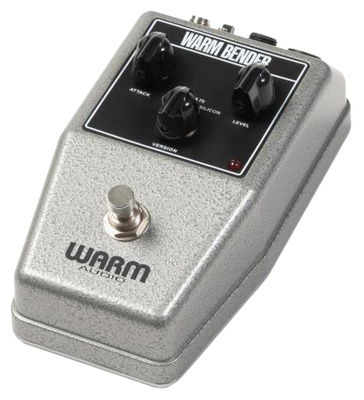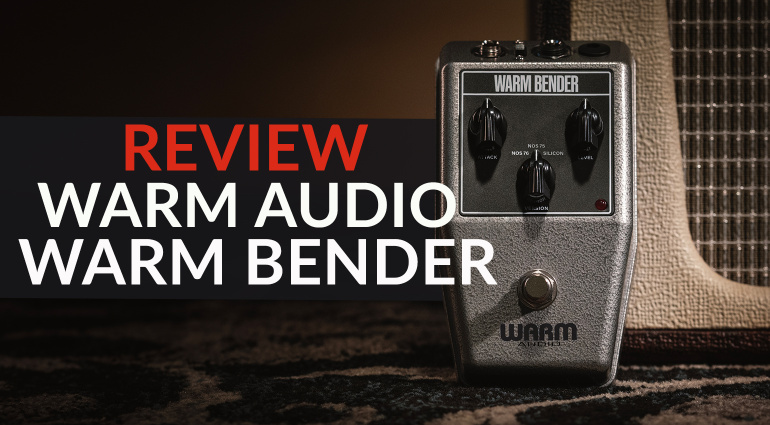Warm Audio Warm Bender Review: Germanium multi-mode Tonebender Fuzz
In this Warm Audio Warm Bender Review, we take a look at the Texas company’s latest fuzz pedal. Based on the circuits of the legendary Sola Sound Tonebender pedals of the 60s and 70s, the Warm Bender adds new features. If you’re looking for the far-out fuzz tones of players such as Jimmy Page, Jeff Beck and Mick Ronson, then you might have come to the right place….
Warm Audio Warm Bender – Standout Features
- An authentic recreation of Sola Sound Tone Bender fuzz circuit
- Three switchable circuit topologies
- Sag function to emulate a discharged battery
- 9v DC power socket
- 9v battery power
- Die-cast enclosure
Warm Bender Review – Return of The Fuzz
Before we get down to the review, we need to cover some history. According to legend, famous guitar session player Vic Flick (Vic played that guitar break on the James Bond theme tune) walked into Maccari’s music store in London with a Maestro FZ-1. Vic requested a fuzz unit with more sustain and that was more readily available.
So began a fuzz legacy with the Tone Bender. If you hop onto the web, you’ll soon disappear down a murky hole of geekery regarding all the different variants. You’ll find loads of variations of the Tone Bender circuit, under lots of different brands. Notably, however, the Tone Bender circuit was also used in the famous, Hendrix-approved Arbiter Fuzz Face.
The Tone Bender had some very high-profile users over the years, including Mick Ronson, Jeff Beck and Jimmy Page. As you might expect such legendary connections mean that prices of vintage units are sky-high. Equally, many boutique reissues carry hefty prices and limited availability…

Whole Lotta Fuzz
Once again, Warm Audio has stepped up to the mark and is now offering an affordable recreation of the classic Tone Bender, in the form of the Warm Bender Fuzz. For you hardcore pedal nerds, the Fuzz Bender is based upon the MKII Tone Bender circuit, but with some very useful tweaks!
NOS germanium transistors are used throughout the Warm Bender. Germanium transistors, while technically “inferior” to silicon in terms of bandwidth, stability and cost, produce a subjectively smoother and rounder distortion.
The Warm Bender offers you a choice of three circuit topologies which employ different combinations of germanium and silicon transistors. NOS76 switches in OC76 and SFT337 transistors, while NOS75 switches in three OC75 transistors. The Silicon setting offers you something unique – a tone-bender circuit but with silicon transistors.
Additionally, you get a “sag” switch, which simulates the effects of a partially discharged battery by reducing voltage to 6V. Undoubtedly, this level of geek-dom is all very fascinating, but what does the Warm Bender actually sound like?


Far Out Fuzz
Chaotic, unpredictable, raucous and wild; all adjectives which immediately spring to mind upon plugging into the Warm Bender. For this Warm Bender review, I tested the Warm Bender with a 100W Marshall half-stack; to get the authentic fuzz experience, the supporting equipment and the gear you use are equally important.
Vintage fuzz circuits are very sensitive to pickup loading and capacitance, so you really need to go directly from your guitar cable and straight into the Warm Bender. It’s been a long time since I’ve plugged into a Tone Bender, but a few characteristics immediately made themselves known to me.
Firstly, I’ve always found that Tone Bender circuits respond much better to an amp that’s got a little bit of dirt to it to begin with. Start turning up the output level of the Warm Bender and there’s enough output level to start pushing the amp. Then, dial up the “attack” control and all psychedelic bedlam is unleashed. This is one wild pedal, errr, man….
Multi-Mode Fuzz with Warm Audio Warm Bender
As mentioned above, the Warm Bender offers you three different circuit topologies. I started, first with the NOS76 setting, a two-transistor circuit. This is perhaps the most “controllable” of all the tones on offer, as it’s a lower gain, lower saturation circuit.
I found the NOS76 setting was useful in adding some edge and attitude onto an already dirty tone. It’s the closest setting here to the tone you might associate with Mick Ronson‘s tone on Bowie’s Spiders from Mars and Aladdin Sane era albums. However, Ronson famously used the Mk1 Tone Bender, which is not a circuit topology offered here… boo!
Moving onto the NOS75 setting and HOLY MOLY GOOD LORD! When you think of saturated, saggy, compressed, warm, violin-like over-the-top fuzzy sustain… here it is! That wild, woody, dark, singing, cello/violin-like sustain is right here. It’s a ridiculously over-the-top tone that’s fantastic for kicking in for solos. Think “Hurdy Gurdy Man” by Donovan or “You Shook Me” by Led Zeppelin and this is the tone. Groooovy baby!

Finally there’s the Silicon and the “Sag” modes. Sag simply starves the circuit of voltage and gives a greatly more compressed attack. It’s a nice feature to have although I thought it made an already heavily compressed tone even muddier and indistinct. Still, a nice extra feature to have.
The Silicon mode, however, really is something unique. There’s more “teeth” to the tone and overall more bandwidth. I’d best describe this as sounding like the mutant half-spawn of a Big Muff and a Tone Bender. It’s a really cool tone and one that could be easily sold in a pedal all by itself.
Fabulous Fuzz?
So, should you look to mount a Warm Bender on your pedalboard? The answer to that depends entirely upon what you’re looking for from a fuzz/distortion pedal! The Warm Bender is an unashamedly “one-trick pony”, but it does that trick extremely well.
If you’re looking for wild, compressed, harmonically signing fuzz tones, then you won’t go far wrong. And, by the inclusion of three different circuit topologies, it’s probably as versatile as a fuzz pedal like this is going to get.
However, I do have a couple of gripes that I found in the course of this Warm Bender review: I would have liked to see the Mk1 Tonebender circuit available in the Warm Bender. Equally, while I appreciate the nice, die-cast enclosure and nod to the original industrial design, could we not have had a proper clip-open battery holder? Having to use a screwdriver to change the battery is a throwback to the 70s I could do without.
Objectively and subjectively, those are the only two notable issues I have with the Warm Bender. It’s affordably priced, offers authentic componentry and tonally achieves exactly what you’d expect from this kind of fuzz pedal.
Pros and Cons: Warm Audio Warm Bender
Pros
- Authentic recreation of MkII Tone Bender Fuzz pedals
- NOS Germanium Transistors
- Multiple switchable circuit topologies
- Unique “silicon Tonebender” circuit
- Switchable “Sag” circuit
- Quality build in a custom diecast enclosure
- 9V Battery or 9V PSU power
- Great value
Cons
- Mk1 Tone Bender circuit missing
- Tools required to change battery
More Information on Warm Audio Warm Bender
- Warm Bender 1: Warm Audio
- Warm Bender 2: Warm Audio












